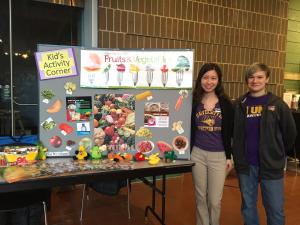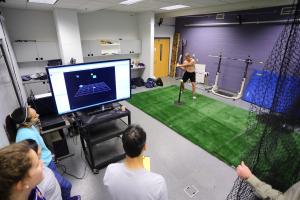Experiences in the Field
The work that students complete outside the classroom is as important as the coursework assigned inside of it. In the College of Education, the two often go hand-in-hand, whether students are getting involved in the community or even traveling outside the state of Iowa for an internship. There’s more than one way to gain hands-on experience in UNI’s School of Kinesiology, Allied Health and Human Services.
 Athletic Training
Athletic Training
The undergraduate athletic training program at UNI is undergoing a transition to the graduate level, but clinical experiences will continue to be a vital component of the program.
“Our students are required to have a multitude of clinical experience opportunities, so we have to ensure that they gain clinical experience with team and individual sports, men’s and women’s sports, equipment-intensive sports,” explained Kelli Snyder, program director of athletic training.
In addition to the athletics programs within UNI, the athletic training program has affiliation agreements with several area high schools. Students are also placed in various physicians’ offices and emergency rooms to learn more about systemic disease and illness, in addition to the musculoskeletal conditions they learn about from their traditional athletic training experiences through athletics or at various physical therapy clinics throughout the Cedar Valley.
Each clinical experience rotation is 7-8 weeks, and supervised by an athletic trainer or a healthcare professional.
 Health Promotion and Education
Health Promotion and Education
“To be honest, every class I teach is hands-on,” said Sherry Hester, instructor and internship coordinator for students in the health promotion and education program.
“I love hands-on,” Hester explained. “That’s how I learn. That’s how I think everyone basically learns, from hands-on. I want to go see and do it.”
She believes hands-on learning experiences, networking opportunities and professional development are all essential elements of health promotion and education, both through their coursework and their experiences in the field.
Classes often require students to leave campus, visiting places around the community or interviewing people relevant to their area of study or career interests.
Prior to internship placement, students will take a professional development-oriented seminar class with the goal of building skills and abilities related to job-seeking, career exploration and field experiences.
Their internship -- which can be completed during a semester or over the summer -- will depend on their emphasis area, but placement sites can include a corporate or worksite placement; hospital or clinical setting; academia; community site; a school setting; commercial or private-for-profit site; the military or government setting; public health departments at the county, state or federal level; a nonprofit organization; or an international destination.
Hester credits dedicated faculty members, a high caliber of students, and strong relationships with outstanding placement sites with strengthening the internship program.
 Leisure, Youth & Human Services (LYHS)
Leisure, Youth & Human Services (LYHS)
Students in LYHS are afforded a variety of opportunities to apply their classroom knowledge in real-world situations through hands-on learning experiences throughout the academic career, culminating in an internship during their final year at UNI.
For example, a class of outdoor recreation students spent this past semester leading environmental education activities for second graders at Hartman Reserve.
Prior to their internship, students are required to complete 500 hours of professional experience, which can be paid or unpaid. The goal is to help build their resume and discern their interests.
Internship opportunities range from working with nonprofit organizations to helping out at youth camps to gaining experience in the area of community parks and recreation.
 Movement & Exercise Science
Movement & Exercise Science
On-campus facilities and laboratories housed within the UNI Wellness and Recreation Center (WRC) allow movement and exercise students to benefit from experiential learning with the latest in technology and equipment at their fingertips.
Instrumentation students have access to a metabolic cart -- the same equipment NASA uses to measure the oxygen consumption and carbon dioxide production of its astronauts.
Not far from the metabolic cart are the underwater weighing tank and a “bod pod,” both of which are used to determine body composition by measuring body mass and volume.
The psychomotor behavior lab is available to students studying motor control, motor learning and sports psychology, with equipment ranging from reaction timers and clock calendars to coordination and vision testing apparatus.
For instruction and research in the analysis of human motion, students will find a home in the biomechanics laboratory. Outfitted with sophisticated computer and sensory technology, the lab uses infrared cameras to capture images beyond what the naked eye can see.
The movement and exercise science program also benefits from a partnership with the athletics department. Students are able to work with student-athletes in the weight room and conduct tests to answer questions and solve problems of interest to either department.
